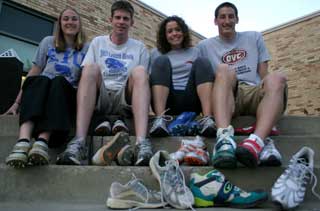Track shoes give athletes more options
Senior thrower Austin Hogue has worn the same pair of javelin boots for the past three years. The toe is almost worn through, but the boots are still useable.
To wear the same pair of shoes in track and field so long is against the norm, but Hogue said there is one reason he’s worn his since his sophomore year.
“It’s hard to find a size 16 javelin shoe,” he said.
Hogue said he has different shoes to compete in his other throwing events, the shot put and discus. This is common for Eastern track and field athletes because there is a specific shoe for nearly every event.
Members of Eastern’s men’s basketball team wear a team shoe. The same is true for the women’s basketball team. Eastern baseball players wear Nike cleats for the most part, with some preferring Reebok, but baseball cleats, regardless of brand, are very similar.
The same cannot be said for track and field shoes.
Training Shoes vs. Competition Shoes
Head track coach Tom Akers said there are differences not only between training shoes and competition shoes but also among the different types of training shoes as well.
Control shoes have a dense material on one side of the shoe to help correct a runner that rolls in on his foot while running.
There is also a cushion training shoe that has a soft insole and midsole. Cushion trainers are meant for more neutral runners who run on the balls of their feet. Akers said cushion trainers feel good and runners like to wear them but may not be the best option for runners who aren’t neutral runners.
The third kind of training shoe is a simple, basic neutral shoe.
Akers said one problem with training shoes is they wear out faster than competition shoes.
“There’s a shoe on the market now that’s only supposed to be worn for a certain number of miles,” Akers said.
Distance coach Geoff Masanet said athletes should not run in their shoes for more than 500 miles. Getting new shoes after 400 miles is preferred.
“Ultimately it stops serving its purpose of support and is a recipe to get injured,” Masanet said.
Akers said the cushion in the shoes could often deteriorate before the shoe really looks worn.
Competition shoes differ from training shoes because they are event specific and are not used as frequently as training shoes, Masanet said.
Thrower’s Shoes
Hogue said the main difference between the shoes he wears as a thrower’s and a runner’s shoes is the placement of spikes and ankle support.
“For a thrower’s shoe,” he said, “it’s more supportive like a tennis shoe.”
Hogue’s javelin boots, unlike runner’s shoes, have large spikes on the heel. The spikes on the left heel of the boots gives more support when he plants his foot to throw.
Hogue’s shoes for shot put and discus differ from runner’s shoes because they have no spikes. He said more surface contact with less grip and drag allow him to spin faster.
Jumper’s Shoes
Sophomore Jenna Uhe, who competes in both the long jump and triple jump, has a different pair of shoes for each event.
Uhe said her long jump shoes have less cushion and longer spikes than her sprint shoes. Her triple jump shoes have more cushion in the heel to promote flat-footed running and jumping.
“For the long jump and triple jump compared to sprints, you have a shorter distance to build up speed,” Uhe said. “With spikes, you can pick up speed a little faster.”
Runner’s Shoes
Senior distance runner Dave Carlson said he looks mainly for comfort. He said he also prefers lighter distance shoes.
“Some heavier shoes don’t let the foot land naturally as it should,” Carlson said. “This affects your stride, and you could get injured.”
Carlson said he regularly wears one pair of spikes for every race because they provide better traction and have a wider base.
Track shoes give athletes more options

Track and field is off and running and that means the closet doors are open as both the men and women try to find their “track or field”,shoes that they have stored away during winter. (John Bailey / The Daily Eastern News)



















![[Thumbnail Edition] Senior Foward Macy McGlone, getsw the ball and gets the point during the first half of the game aginst Western Illinois University,, Eastern Illinois University Lost to Western Illinois University Thursday March 6 20205, 78-75 EIU lost making it the end of their season](https://www.dailyeasternnews.com/wp-content/uploads/2025/03/WBB_OVC_03_O-1-e1743361637111-1200x614.jpg)

















































